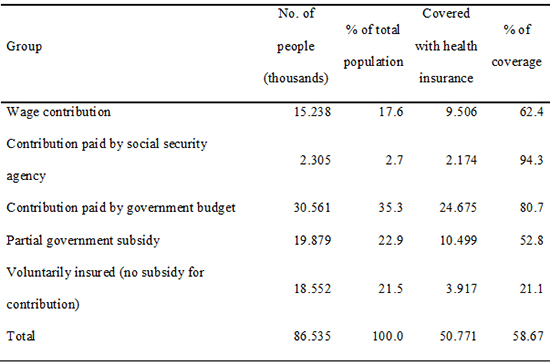1. Ministry of Health. National health account. Hanoi: Ministry of Health;2010.
2. Ha D. Social Health Insurance as a means to achieving universal coverage and more equitable health outcomes. Hanoi: UNICEF;2011.
3. Knaul FM, Wong R, Arreola-Ornelas H, Méndez O. Network on Health Financing and Social Protection in Latin America and the Caribbean (LANET). Household catastrophic health expenditures: a comparative analysis of twelve Latin American and Caribbean Countries. Salud Publica Mex. 2011; 53:s85–s95.
4. O'Donnell O, van Doorslaer E, Rannan-Eliya RP, Somanathan A, Gard CC, Hanvoravongchai P, Hug MN, Karan A, Leung GM, Tin K, et al. Explaining the incidence of catastrophic expenditures on health care: comparative evidence from Asia. 2005. accessed on December 2012. Available at
http://www.equitap.org/publications/docs/EquitapWP5.pdf.
5. Van Doorslaer E, O'Donnell O, Rannan-Eliya RP, Somanathan A, Adhikari SR, Garg CC, Harbianto D, Herrin AN, Huq MN, Ibragimova S, et al. Catastrophic payments for health care in Asia. Health Econ. 2007; 16:1159–1184.
6. Xu K, Evans DB, Kawabata K, Zeramdini R, Klavus J, Murray CJ. Household catastrophic health expenditure: a multicountry analysis. Lancet. 2003; 362:111–117.
7. Vietnam National Assembly. Charter of health insurance. Hanoi: Vietnam National Assembly;1992.
8. Ministry of Health. Roadmap to achieve universal coverage of health insurance in Vietnam: 2012-2015. Hanoi: Ministry of Health;2012.
9. Prime Minister. Decree 63 on healthcare examination and treatment for the poor. Hanoi: Prime Minister;2003.
10. Wagstaff A, Sarah B. The impacts of public hospital autonomization: evidence from a Quasi-natural experiment. World Bank. 2012.
11. Jowett M. Do informal risk sharing networks crowd out public voluntary health insurance? evidence from Vietnam. Appl Econ. 2003; 35:1153–1161.
12. Tien TV, Phuong HT, Mathauer I, Phuong NTK. A health financing review of Vietnam with a focus on social health insurance. Hanoi: World Health Organization;2011.
13. Ekman B, Liem NT, Duc HA, Axelson H. Health insurance reform in Vietnam: a review of recent developments and future challenges. Health Policy Plan. 2008; 23:252–263.
14. Cuong V. The impact of voluntary health insurance on health care utilization and out-of-pocket payments: new evidence for Vietnam. Health Economics. 2011.
15. Jowett M. Voluntary health insurance in Vietnam: an evaluation. Health Popul. 2001; 24:29–44.
16. Vietnam Social Security. Report on two year implementation of the Law of Health Insurance. Vietnam: Vietnam Social Security;2011.
17. Thanh NX, Curt L, Chuc NTK, Niklas R, Anders E, Lars L. People's preferences for health care financing options: a choice experiement in rural Vietnam. Umeå: Umeå University;2005.
18. Ministry of Health and Ministry of Finance. Joint enforcement decree of health insurance law. Hanoi: Ministry of Health and Ministry of Finance;2009.
19. Carrin G. Social health insurance in developing countries: a continuing challenge. Int Soc Secur Rev. 2002; 55:57–69.
20. World Health Organization. Reaching universal coverage via social health insurance: key design features in the transition period. Geneva: WHO;2004.
21. Deutsche Technische Zusammenarbiet (GTZ). Social health insurance: a contribution to the international development policy debate on universal systems of social protection. 2005.
22. Yu SH, Anderson GF. Achieving universal health insurance in Korea: a model for other developing countries? Health Policy. 1992; 20:289–299.
23. Rockefeller-Foundation. Catalyzing change: the system reform costs of universal health coverage. New York: Rockefeller-Foundation;2010.
25. Moon O. The Korean health insurance program. In : Nitayarumphong S, Mills A, editors. Achieving universal coverage of health care. Thailand Ministry of Public Health;1998.
26. Huber E. Options for social policy in Latin America: neoliberal versus social democratic models. In : Anderson GE, editor. Welfare states in transition. SAGE Public;1996. doi:
10.4135/9781446216941.
29. Korea National Health Insurance Cooperation. Health Insurance Statistics Yearbook. Seoul: Korea National Health Insurance Cooperation;2010.
30. Nguyen CV. The impact of voluntary health insurance on health care utilization and out-of-pocket payments: new evidence for Vietnam. Health Econ. 2012; 21:946–966.
31. Republic of Korea. National Health Insurance Act. 2012.
32. Jeong HS. Korea's National Health Insurance: lessons from the past three decades. Health Aff (Millwood). 2011; 30:136–144.
33. Kwon S. Thirty years of national health insurance in South Korea: lessons for achieving universal health care coverage. Health Policy Plan. 2009; 24:63–71.
34. Bayarsaikhan D, Kwon S, Ron A. Development of social health insurance in Mongolia: success, challenges and lessons. Int Soc Secur Rev. 2005; 58:27–44.
36. Lee JC. Health care reform in South Korea: success or failure? Am J Public Health. 2003; 93:48–51.
37. Soe SR, Choi ID, Moon SW, Kim JS, Hwang RI. Satisfaction survey of national healh insurance 2008. National Health Insurance Cooperation;2008.
38. Kang MS, Jang HS, Lee M, Park EC. Sustainability of Korean National Health Insurance. J Korean Med Sci. 2012; 27:S21–S24.







 PDF
PDF ePub
ePub Citation
Citation Print
Print





 XML Download
XML Download